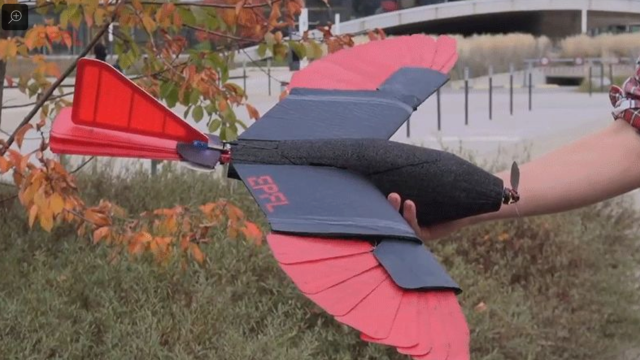Aeronautical engineers have built planes that can streak across the sky at over 6,437 km per hour, but still haven’t come close to designing aircraft that can manoeuvre with the astounding agility of a bird. Researchers at Switzerland’s École Polytechnique Fédérale de Lausanne figured, if you can’t beat ‘em, join ‘em, and have designed a drone with feathered wings that can extend and retract.
Copying a bird’s approach, in which an animal can spread its wings to catch more air to improve manoeuvrability or pull them closer to its body to reduce air resistance and increase speed, isn’t an entirely new idea. Fighter planes like the Grumman F-14 Tomcat feature variable sweep wings to improve their performance at both lower and higher speeds, but it’s a relatively simple design, and the wings move slowly — nothing close to how quickly birds can adapt their aerodynamic shape in flight.
EPFL’s new drone is also a much-improved version over the one that researchers first revealed back in 2016. The size and shape of its morphing wings have been improved to look and function more like a bird’s — it was directly inspired by a northern goshawk, which the researchers studied — while additional adjustable feathers have been integrated into the tail of the craft.
[referenced id=”1013696″ url=”https://gizmodo.com.au/2016/12/researchers-make-an-obvious-discovery-for-improving-drones/” thumb=”https://gizmodo.com.au/wp-content/uploads/2016/12/17/riikbenrcwcoqdzlyjoy-300×143.gif” title=”Researchers Make An Obvious Discovery For Improving Drones” excerpt=”Even the most manoeuvrable aircraft we’ve designed is no match for the agility of a bird. Mother Nature has all but perfected flight, so why are we wasting our time re-inventing the wheel? As researchers at Switzerland’s École Polytechnique Fédérale de Lausanne realised, we should just be copying our fine…”]
The researchers believe the drone’s design could make it better than quadcopters, which have already shown themselves to be extremely manoeuvrable, particularly when flying through cities filled with endless obstacles. The biggest problem with quadcopters, however, is limited flight time, since four motors are being powered at all times. EPFL’s drone uses just one, and can take advantage of the energy-saving tricks that birds use, like gliding or harnessing wind currents and thermals to stay aloft without exerting effort to produce thrust.
Unlike a fixed-wing aircraft, the bird-like drone can also make quick turns, dives, and perform deft aerodynamic manoeuvres with almost as much agility as a quadcopter can. The eventual goal of this approach is to design a drone with improved flight times that can still navigate areas riddled with obstacles like tree-filled forests or cities packed with towering structures. Could it replace quadcopters altogether? Probably not. As the world moves toward autonomous delivery systems, taking to the air with a drone is arguably a lot safer than packing roads with self-driving delivery vehicles. Quadcopters can also deliver a package to a very specific target, and take flight again immediately after. Without landing gear or a reliable way to hold cargo, EPFL’s drone would be limited to other applications such as autonomous reconnaissance or search and rescue.
